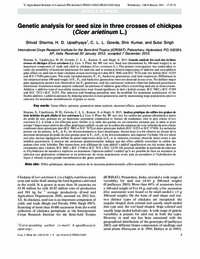Genetic analysis for seed size in three crosses of chickpea (Cicer arietinum L.)

Authors:
Seed size (determined by 100-seed weight) is an
important component of trade and yield in chickpea (Cicer arietinum L.). The present investigation was undertaken to
study the possibility of maternal inheritance for seed size and to estimate relative importance of additive and non-additive
gene effects on seed size in three chickpea crosses involving two desi (ICC 5002 and ICC 7672) and two kabuli (ICC 11255
and ICC 17109) genotypes. The study included parents, F1, F2, backcross generations, and their reciprocals. Differences in
the reciprocal mean 100-seed weight of F1, F2, and backcross generations were not detected in any cross. No definite major
gene segregation pattern was observed in the F2 generation, and the continuous variation observed indicated quantitative
inheritance. Generation mean analysis indicated the presence of additive gene effects controlling seed size in three crosses.
Additiveadditive type of non-allelic interactions were found significant in desikabuli crosses, ICC 5002ICC 17109
and ICC 7672ICC 11255. The selection and breeding procedure may be modified for maximum exploitation of the
fixable additiveadditive epistasis by delaying selection in later generations and by maintaining large populations prior to
selection for maximum recombination of genes to occur.
